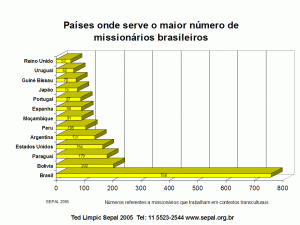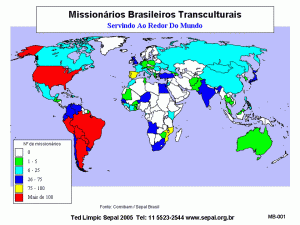 … What they reveal is suggestive, but what they conceal is vital” (Aaron Levenstein).
… What they reveal is suggestive, but what they conceal is vital” (Aaron Levenstein).
I am not a statistician. But I do work with statistics, and have more than half an inkling of how they are put together and presented. And after eight years heading up an evangelical Christian mission, I have another half inkling about the world Christian scene. Perhaps no wonder, then, that this headline caught my attention:
“Brazil becomes second-largest Christian missionary exporter in the world”.
The following paragragh leaves no room for doubt: “Brazil is sending the second highest number of missionaries to the rest of the world, according to the director of a Global Christianity study organisation.” (You can read the original in this Christian Today article.) The statistics, presented by Todd Johnson, director of the Center for the Study of Global Christianity at Gordon-Conwell Theological Seminary,  were revealed on 21st February in a historic reenactment to mark the 200th anniversary of the sailing on 19th February 1812 of the first North American Protestant missionaries, including Adoniram Judson and his wife Ann Hasseltine. With around 60 in attendance it was hardly front-page news, though Reuters did report on the ceremony, this duly being reproduced in the US national and regional press. Most of these, as is natural, focused on the fact that the US is still in “first place” in the league tables of missionaries sent. But a few, such as the Brazil Institute of the Woodrow Wilson International Center for Scholars, highlighted the role of Brazil in a distant “second place” with 34,000 missionaries.
were revealed on 21st February in a historic reenactment to mark the 200th anniversary of the sailing on 19th February 1812 of the first North American Protestant missionaries, including Adoniram Judson and his wife Ann Hasseltine. With around 60 in attendance it was hardly front-page news, though Reuters did report on the ceremony, this duly being reproduced in the US national and regional press. Most of these, as is natural, focused on the fact that the US is still in “first place” in the league tables of missionaries sent. But a few, such as the Brazil Institute of the Woodrow Wilson International Center for Scholars, highlighted the role of Brazil in a distant “second place” with 34,000 missionaries.
What?! Brazil had 34,000 missionaries overseas in 2010? I cannot comment on how many Catholic missionaries may have left Brazil in 2010, but the Protestant workforce does not remotely approach that figure.
Before you ask, yes, I have read Philip Jenkins; I work closely with a good number of great Brazilians and have a soft spot for the contemporary Brazilian mission movement, investing a significant part of my own life and ministry into the raising and training of Brazilians in mission. But I am sorry, there is no way the Brazilian churches had such a significant contingent of Protestant missionaries serving in 2010. As they themselves would say, De jeito nenhum! At the risk of presenting my own distorted view of reality, let’s unpack the stats and try to “figure out” what is going on.
What makes a missionary, a missionary? Setting sail for the “regions beyond” complete with pith helmet and big black Bible?! Whilst nowhere defined, these statistics would seem to view a missionary in purely geographical terms: one who has been sent – or maybe just gone of their own accord – to another country to exercise Christian ministry. Never mind what they are doing or who they are working with, who is impacted by their ministry; once they have crossed a political border, they are “missionaries”.
By focusing exclusively on geography, this understanding of the term fails to take into account the object of ministry. The central task of the missionary has nothing to do with physical relocation, but with the crossing of cultural boundaries. As Eugene Nida noted, “It is not the geographical scope, but the degree of cultural penetration which marks truly effective missionary enterprise”. Two observations follow from this:
Firstly, that one can travel outside one’s own country and not be a missionary. A Korean pastor who moves to Nouadhibou to minister to the Korean fishing industry community located there may well figure on statistics of “overseas” missions, but will most likely never learn the local language or have any measurable impact on the indigenous Mauritanian population whatsoever. Likewise Brazilian pastors of Brazilian congregations in London, Amsterdam or Rome. That is not “missions”, by this definition at least.
Secondly, and conversely, that one can never travel outside the borders of one’s own country and yet be fully immersed in cross-cultural missions. We need look no further than Brazil itself, where several hundred currently work in cross-cultural initiatives with indigenous Amazonian tribes – but would not appear on this list. India, with its thousands of enevangelized ethnic groups, is similarly host to tens of thousands of national cross-culturan workers, mostly from the predominantly Christian South or North-East. Estimates place the number of such workers in the region of 50,000, well above Brazil’s fictitious 34,000, unsung heroes of the global church’s efforts in world evangelization today.
In its simplest terms, missions is about culture, not geography. To leave the cross-cultural dimension out of missions is to strip it of its essential identity. Preachers of the stature of Charles H. Spurgeon may well have said: “Every Christian here is either a missionary or an impostor” (A Sermon and a Reminiscence,” Sword and the Trowel, March 1873), but if everyone is a missionary, then no one is. The term becomes a call to general commitment and loses all cross-cultural content. Whilst the missio Dei can be applied to the whole task of the whole church, missions as a concept cannot be divorced from the cross-cultural expansion of the church; to be a missionary is to be active in this sphere.
Just where did all these Brazilians go? According to the report: “Interestingly, even though the United States sends the most missionaries abroad, it is also the country that receives the most foreign missionaries as well, with 32,400 foreign missionaries arriving to the US in 2010 – the majority of whom come from Brazil.” Johnson further noted that these largely work in Brazilian communities in the Northeast of the US. What a concept, Brazilian missionaries to the US, hardly one of the world’s neediest destinations.
 Whilst it puts the figures much lower – for it refers only to Protestant missionaries working in cross-cultural contexts – research conducted by Comibam, the organization that draws together evangelical Ibero-American mission efforts, confirms this reality. The country outside Latin America that receives most Brazilian missionaries is the United States.
Whilst it puts the figures much lower – for it refers only to Protestant missionaries working in cross-cultural contexts – research conducted by Comibam, the organization that draws together evangelical Ibero-American mission efforts, confirms this reality. The country outside Latin America that receives most Brazilian missionaries is the United States.
I am not casting any doubts on the validity or vitality of the ministy exercised by these Brazilians in the US. Where large numbers of Brazilians – including evangelical Christians – have emigrated, these need organizing, pastoring, discipling. Trained and able Christian ministers should indeed be leaving Brazil to meet their needs; even the US Department of Homeland Security recognizes this. But to call them “missionaries” creates the hugely false impression that the Brazilian church is much further on in its engagement with world evangelization than is in fact the case. Drawing the giant Brazilian evangelical church into a serious commitment to cross-cultural missions is a tough enough assignment as it is, without fuelling misunderstandings that they are already hard on the heels of the US.
 One more thing. The chosen destinations of Brazilian missionaries reveal the same truth as applies to mission the world over. Whilst the US seems to be a favourite destination – the American dream reaches deeply into the soul of many – the majority of workers that leave Brazil are sent to “Christian” nations. What is sometimes referred to as “frontier missions” – the bringing of the gospel to peoples and ethnic groups with no viable church or indigenous Christian witness – remains neglected. Until the Brazilian church begins to take seriously the third of the world that remains beyond the reach of the gospel, it will remain misleading at best to label Brazil as the “second-largest Christian missionary exporter in the world”, and at worst potentially counter-productive. Whilst Brazil has at least started out on that road, there is a long way to go before they are awarded the same reputation in missions as they have in soccer. I look forward to that day :-)
One more thing. The chosen destinations of Brazilian missionaries reveal the same truth as applies to mission the world over. Whilst the US seems to be a favourite destination – the American dream reaches deeply into the soul of many – the majority of workers that leave Brazil are sent to “Christian” nations. What is sometimes referred to as “frontier missions” – the bringing of the gospel to peoples and ethnic groups with no viable church or indigenous Christian witness – remains neglected. Until the Brazilian church begins to take seriously the third of the world that remains beyond the reach of the gospel, it will remain misleading at best to label Brazil as the “second-largest Christian missionary exporter in the world”, and at worst potentially counter-productive. Whilst Brazil has at least started out on that road, there is a long way to go before they are awarded the same reputation in missions as they have in soccer. I look forward to that day :-)
Love your blog Neil…Here I am…Send me!….to New York…
Recently returned to the US from 25 years of ministry to Brazilians in Brazil. I also was amazed and curious when I saw that headline about Brazil being such a large exporter of “missionaries”. It did not fit with the reality I lived while in Brazil. Thanks for some enlightening facts to fill in the blanks. And for the comment on bikinis :-) since I lived in one of Brazil’s beautiful northeastern beach cities.